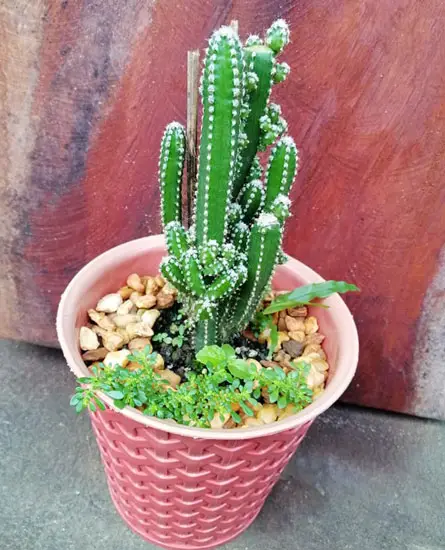A fairy castle cactus, or cephalocereus senilis, is one of the most intriguing succulents. With its whimsical, vertical spires and vibrant yellow flowers, it’s sure to draw admiration from passersby. But how do you get started growing this delightful plant? We’ll look at what you need to know about these unique plants, so you can have a healthy and happy fairy castle cactus in your home or garden.
The first step is understanding their characteristics. A fairy castle cactus has long stems with many segments and branches that grow vertically in an upward spiral pattern, resembling a fairytale-like structure. The leaves are small, green in color, and arranged around the stem-like scales. These plants also produce beautiful yellow blooms during springtime which give off a sweet scent.
Fairy castle cacti thrive best when given plenty of sunlight – preferably direct sun for six hours per day – and well-drained soil with enough moisture to help them stay hydrated without becoming soggy. They’re fairly low maintenance since they don’t require much pruning or fertilizer; however, they will benefit from occasional misting, especially if kept indoors where the air may be dryer than outdoors.
Besides, caring for plants has become a hobby for a lot of garden enthusiasts today. Succulents such as cacti are now increasingly becoming more popular in a lot of different gardens.
And one of the more popular cacti in most American homes is the fairy castle cactus because it actually resembles the spires that you can only see in the castles of fairytale movies. In that regard, how do you grow and take care of a fairy castle cactus?
When growing a fairy castle cactus, the essential part that you should learn and keep in mind is that it is almost reliant on the sun for its nutrients. It also needs its soil to be well-drained. The fairy castle cactus is a pretty easy plant to care for and is ideal for beginner cacti enthusiasts.
There is no need to be an advanced or experienced cacti enthusiast to actually care for a fairy castle cactus because it isn’t the most difficult thing to do. But, at the same time, you must get to know the basics of caring for this cactus, or else you would end up having a hard time. And once you got the fundamentals covered, it’s going to be a smooth ride for you. As such, read on to learn more about taking care of the fairy castle cactus.
Types Of Fairy Castle Cactus
There are several varieties of this species that differ in size and coloration.
- White-haired Fairy Castle: This variety has white hair-like strands sticking out from the sides of its stems and grows up to 6 feet tall when mature. The flowers of this type have bright pink petals with orange centers.
- Purple Haze Fairy Castle: This variety looks similar to the White-haired Fairy Castle but instead of white hairs it has purple ones and its flowers tend to be more lavender in hue. It can reach heights of up to 8 feet when fully grown.
- Golden Flame Fairy Castle: The Golden Flame is the smallest of all three varieties, topping out at around 4 feet in height as an adult plant. Its most distinguishing feature is its golden yellow spines along each stem segment, giving it a vibrant look compared to other types of fairy castle cacti.
No matter which variety you choose, there are some important things for gardeners to keep in mind about these plants’ ideal growing conditions for optimal success.
Ideal Growing Conditions
As the sun sets and the moon rises, so too does the need for a proper habitat in which to cultivate your Fairy Castle Cactus. Much like its namesake fairy tale, this cactus is small yet mighty – provided that it has an environment to thrive in.
First and foremost, find a spot with plenty of indirect sunlight; direct rays can be damaging to these delicate plants since they come from desert climates. Aim for temperatures between 65-85°F (18-29°C), as cooler conditions will cause them to become dormant. Additionally, good air circulation is necessary; gentle breezes help keep pests away while providing vital oxygen exchange within the soil.
It is best to aim for high humidity levels: misting or using a pebble tray are great ways to simulate their native arid habitats without overwatering.
Soil Requirements
Fairy castle cacti require well-draining soil to thrive. A mix with a combination of peat moss, compost, and sand is ideal for this type of plant. Here are the three components you need for your fairy castle cactus:
- Peat Moss – Provides air pockets in the soil that helps it to drain quickly, preventing root rot from developing.
- Compost – Enhances the nutrient content of the soil and adds organic matter which aids in retaining moisture and nutrients.
- Sand – Helps keep drainage holes open so excess water can escape freely, creating an environment where oxygen can reach the roots easily.
To ensure proper growth and health, be sure to choose a potting container with good drainage holes as well as one that’s deep enough to support the long taproots of this type of cactus. When planting your fairy castle cactus, fill up your chosen container halfway with potting soil before carefully transferring your plant into its new home.
Make sure to firmly press down on the soil around the base of your cactus after planting it; doing so will help create a secure bond between your cactus and its new home. With these basic requirements met, all that’s left is fertilizing once every few weeks during the spring and summer months for optimal growth and success with your fairy castle cactus.
Temperature Considerations
The fairy castle cactus is a tropical plant, and as such enjoys warm temperatures. It loves daytime highs of 70-80 degrees Fahrenheit; however, it can tolerate temperatures up to 90°F for short periods of time if given adequate ventilation and humidity. Nighttime lows should stay between 50-60°F for optimal growth.
Here are three tips to help your fairy castle cactus thrive:
- Place the pot in an area that’s not exposed to cold drafts or hot radiators.
- Move outdoor plants indoors during the winter months when temperatures drop below 50°F.
- Keep an eye on temperature changes–if there’s a sudden spike or dip, take corrective action immediately.
Humidity is also important for this type of plant–ideally, you want levels around 30% to 40%. If the air is too dry where you live, try using a humidifier or misting your cactus with water every few days (but avoid getting its spines wet).
Light Requirements
Fairy castle cacti thrive best in bright, indirect light. They should be placed near a window that faces east or west to get the most beneficial rays of sunlight without being exposed to too much intense direct light. If you have an area with very strong sun exposure, add sheer curtains to soften and filter out some of the harshnesses.
Be careful not to overdo it though; too much sun can cause discoloration or burn on your plant’s delicate spines. Since these plants are native to tropical regions, they need several hours of bright daylight each day for optimal health and growth. Monitor them often so you can see if their leaves start showing signs of bleaching or yellowing due to excessive sunlight.
If there is no natural source of light available, consider investing in artificial lighting such as LED grow lights or fluorescent bulbs that will provide enough brightness for your plant’s needs.
Watering Practices
Now that you have your fairy castle cactus in the pot of its choice, it’s time to think about how much water and when to give it. Overwatering can be just as damaging as underwatering so getting a watering routine down is key for success.
When it comes to watering this type of cacti, less is more. Depending on where you live, giving your fairy castle cactus one deep soak every two weeks should suffice during the warm season and reduce that frequency if temperatures dip below freezing. To check if it needs water, stick your finger an inch or two into the soil; if it feels dry then go ahead and water thoroughly until excess drains from the bottom hole. This will ensure root rot doesn’t occur due to overwatering.
During winter months, decrease watering even further since they tend to become dormant while temperatures are low. If you’re worried about not providing enough hydration but also don’t want to risk drowning them with too much H2O, mist their leaves with lukewarm water instead–it won’t cause any damage and will help keep moisture levels up without saturating their roots.
With these simple guidelines in mind, your fairy castle cactus will thrive indoors or outdoors depending on climate and location–now let’s move on to pruning guidelines for optimal health.
Fertilization Schedule
Now that we have discussed the pruning guidelines for your fairy castle cactus, let’s move on to fertilization. It is important to maintain a regular fertilizer schedule in order to ensure optimal growth and health of your fairy castle cactus.
The best way to nourish your plant is through liquid fertilizer applications every two weeks during its active growing season, which typically occurs between April and October. During this time, make sure you use a high-quality balanced fertilizer with an N-P-K ratio of 8:8:8 or 10:10:10. Always dilute the fertilizer according to manufacturer instructions as too much can burn roots and cause stunted growth. Be sure to apply the diluted solution directly onto wet soil around the base of the plant from late spring to early autumn.
In winter months when there are fewer hours of daylight and temperatures drop below 55ºF (12ºC), it’s important to reduce feeding frequency since your fairy castle cactus will be dormant during this period. Once every four weeks should be sufficient enough for providing the necessary nutrition without overdoing it.
Propagation Tips
Now that we have gone over soil requirements, let’s discuss propagation tips for the fairy castle cactus. Propagating your own plants can be a rewarding experience and is surprisingly easy to do with this type of succulent. The first step in propagating these plants is to select healthy stems that are at least four inches long. Cut them off close to the base of the plant using scissors or a sharp knife and set them aside.
The next step involves allowing the cuttings to dry out completely on wax paper before planting them in a well-draining potting mix. Make sure each cutting has plenty of room as overcrowding will lead to disease and rot. To ensure success, it is important to water sparingly, but often enough so the soil remains damp but not soggy. Providing adequate light is also essential for optimal growth; aim for about 4-6 hours per day from a sunny window sill or another bright area indoors.
Once established, you can enjoy watching your new little cacti grow into beautiful specimens. With some patience and proper care, they should reach maturity within 2-3 years.
Potting And Repotting
“A stitch in time saves nine”, and the same sentiment applies to your fairy castle cactus. Potting and repotting are necessary for a healthy, thriving plant life cycle. First, choose an appropriate pot size; it should be two inches larger than the current one with ample drainage holes at the bottom.
Then use well-draining soil specifically designed for succulents or cacti; avoid regular garden soil as it holds too much moisture. When you’ve got everything ready, gently remove the root ball from its old pot before carefully placing it into its new home. Firmly press down on the surface of the soil while filling any gaps around the sides of the rootball.
After repotting, allow some time for the roots to adjust and settle into their new environment before watering thoroughly until excess water drains out of the bottom hole(s). To prevent over-watering, wait until most of this water has evaporated away before adding more—this is especially important during winter months when plants go dormant and require less hydration.
Pruning Guidelines
Fairy Castle Cactus (Acanthocereus tetragonus) is a stunning and unique species of cacti that can be found in the tropical forests of Mexico and Central America. Pruning these plants requires a gentle touch, just like raising any other living thing. Here’s how to properly prune your Fairy Castle Cactus:
- Remove damaged, dead, or decaying growth carefully with clean shears or pruners.
- Cut away stems near the base of the plant if you want to propagate it.
- Shape and rejuvenate older specimens by cutting back stems flush with the ground or potting container edge.
- Trim off yellowed leaves at their tips to encourage fresh new foliage.
- Don’t forget to wear protective gloves while trimming.
When pruning your Fairy Castle Cactus, always remember that less is more; don’t go overboard as this could potentially harm your plant. Instead, opt for slow but steady shaping over time so that its natural beauty remains intact. With proper care and attention, you’ll have a healthy and flourishing specimen.
Pest Control Methods
Pests can be a nuisance for any garden, and the fairy castle cactus is no exception. It’s like having an unwanted houseguest; they’ll come in uninvited, create chaos, but won’t leave even after you’ve asked them nicely to go away. Fortunately, there are some ways we can rid our gardens of these pests without resorting to harsh chemicals.
One way to prevent infestations from occurring in the first place is by providing plants with healthy soil and enough water or fertilizer. When soil is too dry or nutrient-deficient, it invites bugs to seek food or shelter. Keeping weeds out of the area around your plant also helps reduce potential pest issues as many insects use them as breeding grounds before moving on to other nearby plants. Finally, keeping your garden clean by removing dead leaves or flowers will help deter potential invaders.
Good maintenance practices are key when it comes to controlling pests organically. Pruning back overgrown branches prevents overcrowding which could attract certain types of beetles while physically removing larger insects manually also works if done regularly. Adding beneficial predatory insects such as ladybugs or praying mantises can also help keep populations down since they feed on common pests that target our cacti friends.
Signs Of Poor Health
The fairy castle cactus is a delicate and lovely creature, but it can endure much hardship. When its health is poor, the signs are there for us to read like a book. Its leaves may droop or curl inwards; its blooms may be few and small with no scent; and its stems may start to bend at strange angles as if they were giving up on life.
Sometimes these symptoms are caused by an imbalance of elements – too little light or water, not enough air circulation, or soil that’s too heavy or acidic. If nothing else helps, it could just be growing pains. But more often than not, it’s something more serious: disease or insect infestation.
On top of those afflictions come common ailments such as root rot and fungus gnats. The best way to deal with them is prevention – keep your cactus well-watered yet never soggy, in a place where pests won’t bother it, and make sure all containers have drainage holes so excess moisture doesn’t linger around the roots. With some vigilance and care from you, your beloved fairy castle can stay healthy and happy for many years to come.
Common Problems With Fairy Castle Cactus
Before we get to know more about how to care for a fairy castle cactus, you must understand the common problems and issues regarding this plant to best prepare yourself right away before you even get to learn how to grow one.
In relation to that, here are the common problems that fairy castle cacti face:
1. Giving it a lot of water
When it comes to succulents, you need to know first that these plants are used in hot and arid places that don’t have a lot of water. Surviving in such conditions has allowed them to stay healthy even with minimal water.
That’s why you have to understand that you don’t need to give your fairy castle cactus as much water as most other plants do, or else this can lead to problems such as rots in its stem, leaves, and roots. In that regard, make sure that you only give your cacti the right amount of water while also getting rid of parts that are beginning to rot.
2. Pest infestation
It is not rare for you to encounter pests in any plant that you take care of. The same goes for the fairy castle cactus because it will encounter pests like the scale bug from time to time. You can detect the presence of this pest if you see that your cactus has brown spots all over.
This can be problematic because it will make the plant ugly to look at and unhealthy to the point that it wouldn’t survive for long, especially when the pest infection gets too serious.
3. Fungi
Similar to how you can detect pests in your cacti, fungal infection can also cause the brown spots found on the plants. This can happen when the fairy castle cactus is staying in a pot that is too moist because you gave it too much water.
So, the best way to combat pests and fungal infection is by making sure that you only give your cacti the right amount of water. A natural insecticide such as neem oil may also be a good option for getting rid of pests and fungi.
How Much Sun Does a Fairy Castle Cactus Need?
The fairy castle cactus needs a lot of sunlight to thrive well, even when you place it indoors. When the plant gets all of the ample sunlight it needs, it can survive well enough to produce nutrients and stay in top shape.
In that regard, when you are caring for a fairy castle cactus, you must place it in a spot that gets a ton of sunlight the entire day so that you won’t have to encounter problems regarding the plant’s lack of sunlight.
If you are leaving it outdoors, make sure that it is placed in an area with no shade but is still covered well enough to get more water than it can handle whenever it is raining. However, if you live in a particularly cold region, you might want to keep it away from the outdoors because too much cold can kill the fairy castle cactus, considering that this succulent is used to dry and arid areas.
It is probably best to allow the fairy castle cactus to stay indoors to ensure that it doesn’t get exposed to the cold weather and rainwater outside. When keeping the cactus indoors, find a spot that gets a lot of sunlight, such as by the window but make sure that the window is not too ventilated or that the spot is away from a fan or an air-conditioner because cold air can actually be detrimental to the fairy castle cactus’s health.
How Much Water Should My Fairy Castle Cactus Get?
Even though the fairy castle cactus has evolved to adapt in harsh areas for most plants, it still needs water to survive. But the most important thing you need to factor in here is that you shouldn’t water it as often as you would when it comes to other plants because the fairy castle cactus can survive on little water.
On top of that, giving too much water to the fairy castle cactus will lead to health problems in the future, and you don’t want that to happen to your plant.
It would help if you were using a pot with enough drainage holes that are also big enough to allow water to pass through easily. As soon as water pours out of the holes, stop watering the soil as the cactus will have enough water for its roots to drink at this point.
Unlike most plants, you need to apply the water directly to the soil of the fairy castle cactus. Also, the soil must dry out completely before you can resume irrigation once more. You don’t have to keep the soil as moist as possible as this can lead to over-watering on the part of your cactus.
Best Way To Take Care of a Fairy Castle Cactus
When taking care of a fairy castle cactus, two things are important. First of all, because it needs a lot of sunlight, the cactus should be kept in an area where it gets exposed to the sun the entire day. And the second is that you should plant it in a pot that can efficiently drain the soil so that the soil won’t get too flooded and the cactus won’t get too much water than what it can handle.
The best pot to use for a fairy castle cactus is a standard cactus clay pot that has drainage holes large and plenty enough for water to pass through efficiently. Use a soil mixture that combines standard potting soil and sand to mimic the conditions that this cactus often sees in its natural habitat. And when watering it, make sure that the water passes through the drainage well and that the soil should be completely dry before you water it again.
When winter strikes, you can decrease the water you give to your cactus by about half because it doesn’t need a lot of water to survive during such a season. Also, giving the usual water to your fairy castle cactus during the winter can lead to health problems because it will take more time for the soil to dry out completely whenever the weather is too cold.
Find a sunny location indoors if you are in a cold climate area, but you can place it outdoors so long as the conditions aren’t too cold for the cactus. The fairy castle cactus needs to be in a spot that will allow it to get as much sunlight as it needs without getting exposed to cold air or drafts.
If the cactus has grown too big for its pot or if you simply want to re-pot it, you should re-pot it in a pot that allows it to have as much space as it needs. That’s because the fairy castle cactus’s roots require a ton of soil space.
After all, most cacti are naturally used to huge spaces in the wild, especially considering that the soil is arid areas are not too rich in nutrients.
Why Does The Fairy Castle Cactus Turn Brown?
You may notice that brown spots can be seen on your fairy castle cactus. The main cause of such brown spots are actually pests such as scale bugs, which can easily propagate on your cacti and other plants. Your cacti will turn brown in certain spots because these insects will suck out the nutrients from those spots. If you want to keep scale bugs away from your cacti, you can use neem oil as a natural insecticide.
Another common reason for your fairy castle cactus turning brown is fungi. Fungi can easily grow on your cactus whenever the conditions become moist enough for the fungi to propagate. That’s why we cannot stress how important it is for you to make sure that you regulate the water you give to your fairy castle cacti, or else the plants may end up with health problems that can easily lead to their quick death.
Did you find this post useful? Would you like to get back to it later? Save THIS PIN below to your garden, cacti, cactus, and succulents boards on Pinterest! Thanks 🙂




